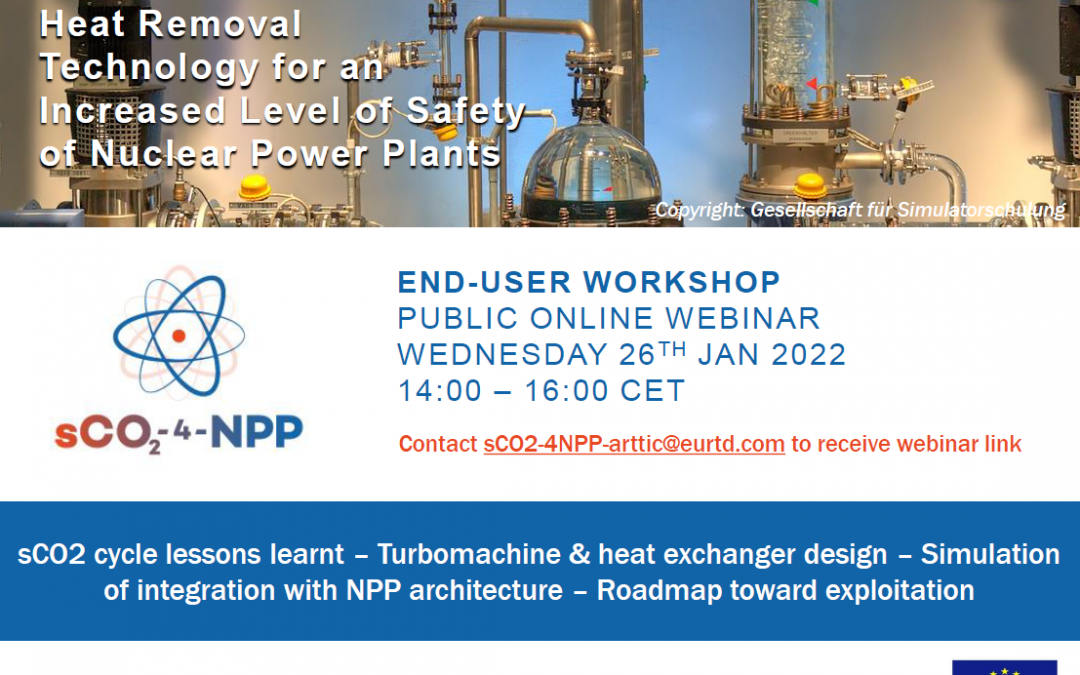Scientific Publications and Press Articles
Scientific Publications
Hacks A J, Schuster S and Brillert D, 2020, “Impact of volumetric system design on compressor inlet conditions in supercritical CO2 cycles”, in GPPS Chania20 Proceedings, Global Power & Propulsion Society, pp 1-7.
Abstract:
The paper aims to improve the understanding of the dependency of compressor inlet conditions close to the critical point in supercritical CO2 (sCO2) cycles on different volumetric cycle designs. The compressor inlet conditions are fixed by the specific static outlet enthalpy of the main cooler and the static pressure determined by the mass of CO2 in the closed cycle. While in a previous study the authors analyzed effects on the compressor inlet conditions with respect to the specific static enthalpy in the pseudocritical region for constant inlet pressure, this paper focuses on the influence of the volume of the heater and cooler. The analysis is based on experimental observations from two different experimental sCO2 cycles, the SUSEN loop and the HeRo loop. The change of compressor inlet pressure upon change of the cooling power is substantially different and caused by the different volumetric design of the cycles. A simple model based on the volumes of the hot and cold sections in the cycle is developed to understand the dependency of compressor inlet conditions on the volumetric design. In terms of the volumetric design of the cycle, the paper will improve the knowledge of the challenges in stable compressor operation close to the critical point.
Link to publication: https://gpps.global/chania20-proceedings/
Tioual-Demange, S, Bergin, G, Mazet, T, & de Camas, L. "Industrial Technical Development and Qualification of Highly Efficient Stainless Steel Plates and Fins Heat Exchanger for Heat Removal Supercritical CO2 Brayton Cycle Applied to Nuclear Power Plants." Proceedings of the ASME 2020 Fluids Engineering Division Summer Meeting collocated with the ASME 2020 Heat Transfer Summer Conference and the ASME 2020 18th International Conference on Nanochannels, Microchannels, and Minichannels. Volume 1: Fluid Applications and Systems; Fluid Measurement and Instrumentation. Virtual, Online. July 13–15, 2020. V001T01A008. ASME.
Abstract:
The sCO2-4-NPP european project aims to develop an innovative technology based on supercritical CO2 (sCO2) for heat removal to improve the safety of current and future nuclear power plants.
The heat removal from the reactor core will be achieved with multiple highly compact self-propellant, self-launching, and self-sustaining cooling system modules, powered by a sCO2 Brayton cycle.
Heat exchangers are one of the key components required for advanced Brayton cycles using supercritical CO2. Fives Cryo company, a brazed plates and fins heat exchangers manufacturer, with its expertise in thermal and hydraulic design and brazing fabrication is developing compact, and highly efficient stainless steel heat exchanger solution for sCO2 power cycles, thanks to their heat exchange capability with low pinch and high available flow sections.
The aim of the development of this specific heat exchanger technology is to achieve an elevated degree of regeneration. For this matter, plates and fins heat exchanger is a very interesting solution to meet the desired thermal duty with low pressure drop leading to a reduction in size and capital cost. The enhancement of the mechanical integrity of plates and fins heat exchanger equipment would lead to compete with, and even outweigh, printed circuit heat exchangers technology, classically used for sCO2 Brayton cycles.
sCO2 cycle conditions expose heat exchangers to severe conditions. Base material selection is essential, and for cost reasons, it is important to keep affordable heat-resistant austenitic stainless steel grades, much cheaper than a nickel-based alloy. Another advantage of high compactness of plates and fins heat exchangers is the diminution of the amount of material used in the heat exchanger manufacturing, decreasing even more its cost.
The challenge here is to qualify stainless steel plates and fins heat exchangers mechanical resistance, at cycle operating conditions, and meet with pressure vessels codes and regulations according to nuclear requirements.
One critical point in the development of the heat exchangers is the design of the fins. As secondary surface, they allow the maximization of heat transfer at low pressure drop. At the same time mechanical strength has to be guaranteed. To withstand high pressure, fins thickness has to be significant, which makes the implementation complicated. Efforts were dedicated to successfully obtain an optimal shape. Forming of fins was therefore improved compared to conventional techniques. Important work was undertaken to define industrial settings to flatten the top of the fins leading to a maximum contact between the brazing alloy and the fins. Consequently brazed joints quantity is minimized inducing a diminution of the presence of eutectic phase, which is structurally brittle and limits the mechanical strength of the construction.
A metallurgical study brings other elements leading to the prevention of premature rupture of the brazed structure. The idea is to determine an optimized solidification path and to identify a temperature range and holding time where the brazed joint is almost free of eutectic phase during the assembly process in the vacuum furnace.
Link to publication: https://asmedigitalcollection.asme.org/FEDSM/proceedings-abstract/FEDSM2020/83716/V001T01A008/1087973
Ren H, Hacks A, Schuster S, Brillert D, "Mean-line analysis for supercritical CO2 centrifugal compressors by using enthalpy loss coefficients" in The 4th European sCO2 Conference for Energy Systems, March 23-24, 2021
Abstract:
In order to develop the technology of carbon dioxide at so-called supercritical state (sCO2) further, quick and reliable
design tools for the different system components, e.g. centrifugal compressors, are required.
In this study, a computer program is developed to predict the performance of centrifugal compressors with sCO2 as working fluid. This computer program is based on mean-line analysis, calculates the fluid parameters at selected sections of the meridional plane and plots the performance maps. So-called enthalpy loss coefficients are utilized to describe the difference between the isentropic and the polytropic process.
In addition to previous studies, the presented model intends to predict the performance of sCO2 centrifugal compressor with a shrouded impeller and a vaneless diffuser. For this purpose, corresponding loss coefficients are incorporated. Subsequently, the predicted results of this work are compared and validated
with computational fluid dynamics (CFD) and experimental results from the EU-project sCO2-HeRo. The prediction of the computer program fits within 5% deviation to the CFD results, and about 4% to the experimental results regarding to pressure ratio.
Link to publication: Mean-line analysis for supercritical CO2 centrifugal compressor by using enthalpy loss coefficients (uni-due.de)
Hofer M, Ren H, Hecker F, Buck M, Brillert D, Starflinger J, "Simulation and analysis of a self-propelling heat removal system using supercritical CO2 at different ambient temperatures" Energy, Volume 247, 2022
Abstract:
The supercritical carbon dioxide (sCO21) heat removal system, which is based on a closed Brayton cycle with sCO2 as a working fluid, is an innovative heat removal system for existing and future nuclear power plants. This paper provides the design, layout and control of the system based on assumptions developed in the project sCO2-4-NPP. A self-propelling operational readiness state enables a fast start-up and consumes only 12% of the design thermal power input. The system is analysed over a wide range of ambient and steam-side conditions in ATHLET, using performance maps for the turbomachinery, which were designed recently. The performance analysis suggests that it is a good option to operate the system at the design compressor inlet temperature of 55 °C at any boundary condition. With decreasing thermal power input, the rotational speed of the turbomachinery must be decreased to keep the system self-propelling. Moreover, the turbomachinery design with a higher surge margin is preferred. By controlling the compressor inlet temperature via the air mass flow rate and turbine inlet temperature via the turbomachinery speed, the heat removal system is successfully operated in interaction with a pressurized water reactor.
DOI: https://doi.org/10.1016/j.energy.2022.123500
Link to publication: https://www.sciencedirect.com/science/article/pii/S0360544222004030
Timoual-Demange S, Voirin V, Hofer M, Hecker F, Buck M, Starflinger, "Conceptual design, optimisation and qualification of highly efficient brazed plates and fins heat exchangers for heat removal sCO2 Brayton Cycle to increase the safety of nuclear power plants" in the 4th European sCO2 Conference for Energy Systems, March 23-24, 2021, Online Conference
Abstract:
The sCO2 sCO2-4-NPP European project aims to develop an innovative technology based on supercritical CO2 (sCO2) for heat removal to improve the safety of current and future nuclear power plants.
The heat removal from the reactor core will be achieved with multiple highly compact self-propellant, self-launching, and self-sustaining cooling system modules, powered by a sCO2 Brayton cycle.
Heat exchangers are one of the key components required for advanced Brayton cycles using supercritical CO2. To this end, two compact and highly effective brazed plates and fins heat exchangers are designed:
- a main heat recovery heat exchanger (CHX), which allows the heat transfer directly from the steam generator to the sCO2 sCO2-4-NPP cycle,
- a heat sink exchanger (DUHS), which evacuate the remaining heat to the atmosphere.
An important work has been achieved in the frame of this project to conceive the pre liminary design of these components, in close collaboration between Fives Cryo, a French brazed plates and fins heat exchangers manufacturer, the Institut für Kernenergetik und Energiesysteme (IKE) of University of Stuttgart and KSG/GFS Institute, a simulator center, both in Germany.
In fact, several constraints needed to be taken into account. For instance, for the DUHS, the low fans power available for the cycle and the necessary air flow for effective heat exchange implies considering almost in existing pressure drops on the air side.
To this end, very specific design ideas has been addressed to meet the desired thermal duty.
Also, this project benefits from the recent results achieved among the European project sCO2-flex, related to the mechanical resistance of heat exchanger components, the assembly process and their thermal and hydraulic performances,
along with Fives Cryo expertise and background.
A second challenge of the sCO2-4-NPP project is to qualify the designed plates and fins heat exchangers, at cycle operating conditions, in order to meet with pressure vessels codes and regulations according to nuclear requirements.
This paper presents the work achieved on the design of DUHS heat exchanger components and a preliminary part of the qualification of this equipment according to nuclear power plants regulations.
DOI: 10.17185/duepublico/73971
Link to publication: Conceptual design and qualification of highly effective heat exchangers for heat removal sCO2 Brayton cycle to increase the safety of nuclear power plants (uni-due.de)
Hofer M, Buck M, Starflinger J, "Operational analysis of a self-propelling heat removal system using supercritical CO2 with ATHLET" in the 4th European sCO2 Conference for Energy Systems, March 23-24, 2021, Online Conference
Abstract:
This study proposes preliminary guidelines for the design and operation of a supercritical carbon-dioxide (sCO2) heat removal system for nuclear power plants. Based on a thermodynamic optimization the design point is calculated incorporating an existing small-scale compressor map.
The behavior of the cycle is tested under varying boundary conditions on the steam side of the compact heat exchanger. The simulations are carried out with the thermal-hydraulic system code ATHLET, which has been extended for the simulation of sCO2 power cycles. The extensions include the thermodynamic properties, heat transfer and pressure drop correlations as well as performance map based turbomachinery models, which take the real gas behavior of sCO2 into account.
During the decay heat transient, compressor surge occurs in some of the simulated cases. In order to avoid compressor surge and to follow the decay heat curve, the compressor speed is reduced together with the steam temperature. This enables to operate one single system down to a thermal load of less than 50 % even under the design restriction caused by the application of the existing compressor performance map.
DOI: 10.17185/duepublico/73983
Link to publication: Operational analysis of a self-propelling heat removal system using supercritical CO2 with ATHLET (uni-due.de)
S. Schuster, A. Hacks, D. Brillert, "Lessons from testing the sCO2-HeRo turbo-compressor-system" in the 7th International Supercritical CO2 Power Cycles Symposium, Paper 15, March 31 – April 2, 2020
Abstract:
Motivated by the growing interest in sCO2 Joule-Brayton cycles as a future power plant technology for both energy conversion and safety back-up systems, this paper presents the
experimental proof of concept for a small turbo-alternator-compressor unit (TAC).
After a briefdescription of the system as a whole, the design of the TAC is given in detail. This is followed by an outline of the experimental study consisting of the compressor performance map (pressure ratio vs. mass flow rate) complimented with findings on the cycle operation. Comparison between the experimental performance map and the CFD calculations indicates the validity of the CFD code for sCO2 compressor calculations and hence this code is suitable for design and performance map calculations.
The paper discusses two different approaches for determining the compressor efficiency and proposes inlet density measurements as a more accurate method compared to temperature measurements. One of the findings of the test campaign is the stable operation of the cycle, which is often believed to be an issue caused by the high dependency of compressor inlet density on temperature.
Therefore, one of the contributions of this paper is to explain briefly that compressor inlet state variations should be considered as a function of enthalpy fluctuations rather than temperature fluctuations.
Link to publication: Lessons-from-testing-the-sCO2-HeRo-turbo-compressor-system_rev04.pdf (sco2-flex.eu)
Hacks AJ, Brillert D. Turbomachine Operation with Magnetic Bearings in Supercritical Carbon Dioxide Environment. International Journal of Turbomachinery, Propulsion and Power. 2022; 7(2):18.
Abstract:
In the sCO2-HeRo project, the Chair of Turbomachinery at the University of Duisburg-Essen developed, built and tested a turbomachine with an integral design in which the compressor, generator and turbine are housed in a single hermetic casing. However, ball bearings limited operation because their lubricants were incompatible with supercritical CO2 (sCO2) and they had to operate in gaseous CO2 instead.
To overcome this problem, the turbomachine was redesigned built and tested in the sCO2-4-NPP project. Instead of ball bearings, magnetic bearings are now used to operate the turbomachine with the entire rotor in sCO2. This paper presents the revised design, focusing on the usage of magnetic bearings. It also investigates whether the sCO2 limits the operating range.
Test runs show that increasing the density and rotational speed results in greater deflection of the rotor and greater forces on the bearings. Measurements are also analyzed with respect to influence of the density increase on the destabilizing forces in the rotor–stator cavities. The conclusion is that for the operation of the turbomachine, the control parameters of the magnetic bearings must be adjusted not only to the rotor speed, but also to the fluid density. This enabled successful operation of the turbomachine, which reached a speed of about 40,000 rpm during initial tests in CO2.
DOI: 10.3390/ijtpp7020018
Link to publication: https://doi.org/10.3390/ijtpp7020018
Hacks, A. J., Abd El Hussein, I., Ren, H., Schuster, S., and Brillert, D. (January 25, 2022). "Experimental Data of Supercritical Carbon Dioxide (sCO2) Compressor at Various Fluid States." ASME. J. Eng. Gas Turbines Power. April 2022; 144(4): 041012
Abstract:
This paper presents experimental data on a centrifugal compressor operated with CO2. Temperature and pressure at the inlet of the compressor are varied to cover the supercritical region from the liquid-like to the gas-like region. In addition, inlet conditions in the two-phase region are also included. Thus, the experimental test campaign considers thermodynamic conditions relevant for the future energy conversion with sCO2-Joule cycles. Experimental results are presented as compressor pressure ratio versus inlet mass flow rate at different rotational speeds and throttle positions. Reliable conclusions can be drawn from the experimental results since the reproducibility of the measurements has been demonstrated by conducting experiments in two different test rigs, and measurement uncertainties are reported. The entire compressor geometry is disclosed in a data repository, including computer-aided design models, and input files suitable for mean-line and grid generation programs. Thus, the experimental results are exploitable by the scientific community and pave the road for validated analysis and design tools in the context of the sCO2-Joule cycle. The presented results open the possibility to estimate uncertainties of analysis and design tools with little effort since geometry information can be quickly integrated. The experimental data are already used in this paper to obtain the accuracy of a computational fluid dynamics (CFD) code and a mean-line program for sCO2. In addition to quantifying uncertainties, the results presented can be used to identify shortcomings of existing tools. This can be an essential step in the exploration of the sCO2-Joule cycle.
DOI: 10.1115/1.4052954
Link to publication: https://doi.org/10.1115/1.4052954
Press Articles
New sCO2 project: sCO2-4-NPP launches in Paris
Announcement of the sCO2-4-NPP project launch from our “sister” project sCO2-Flex:



